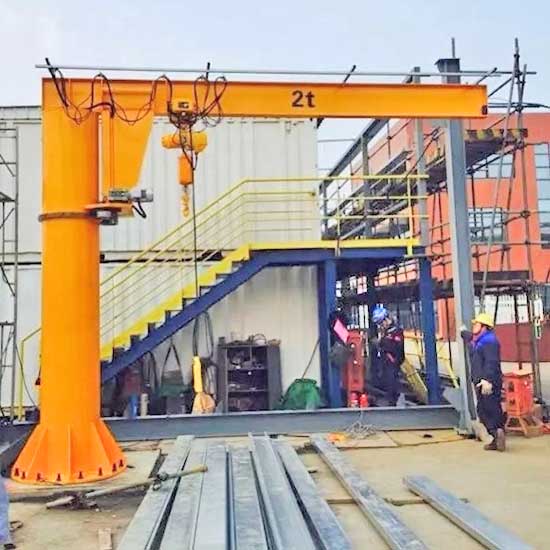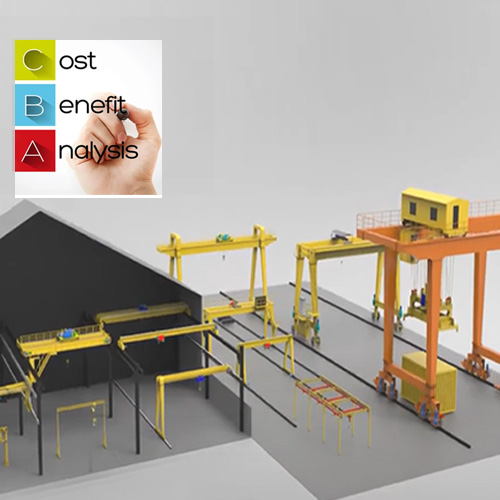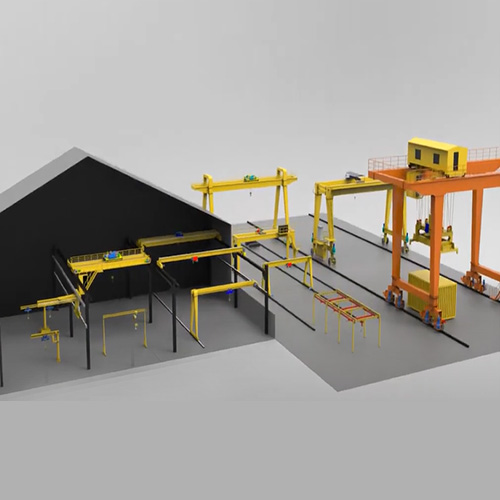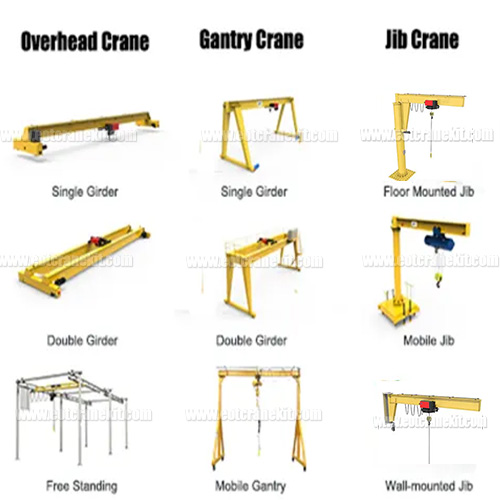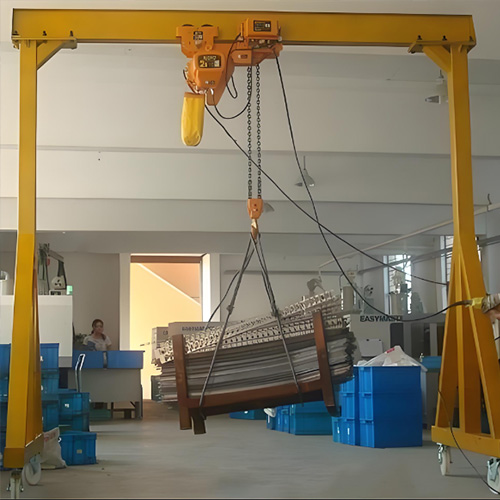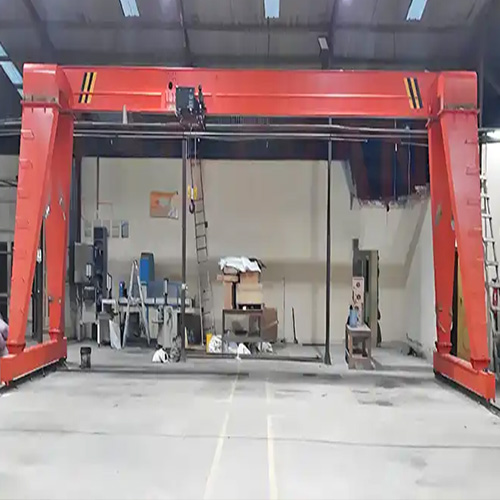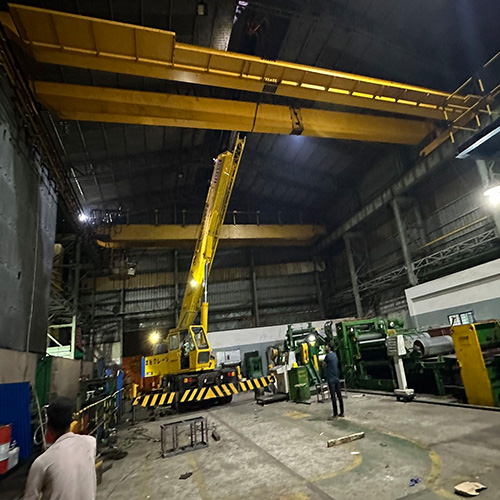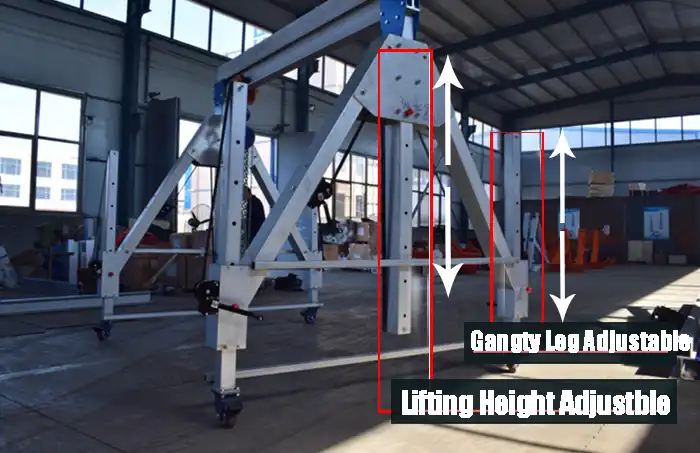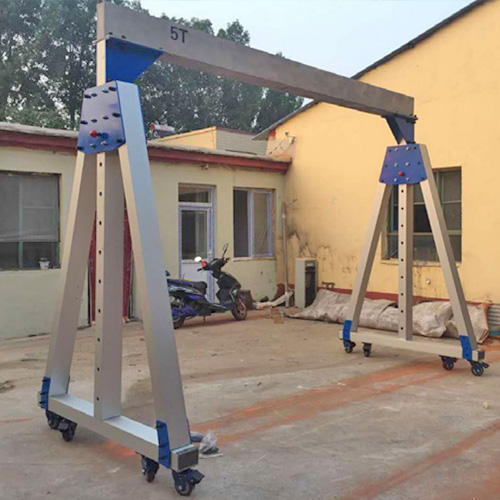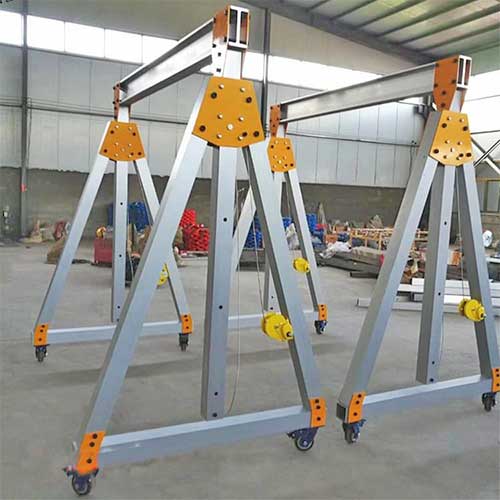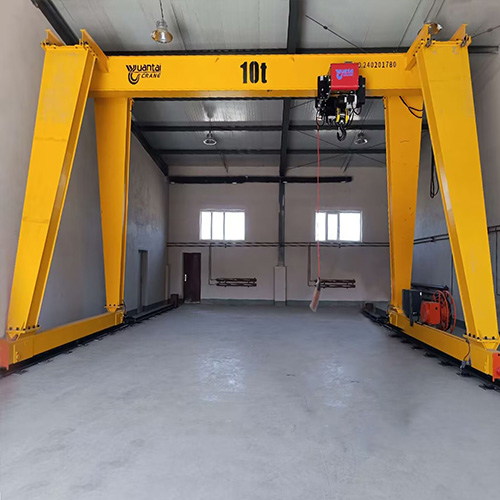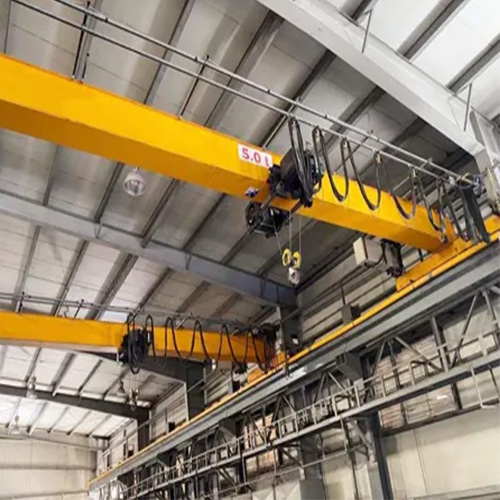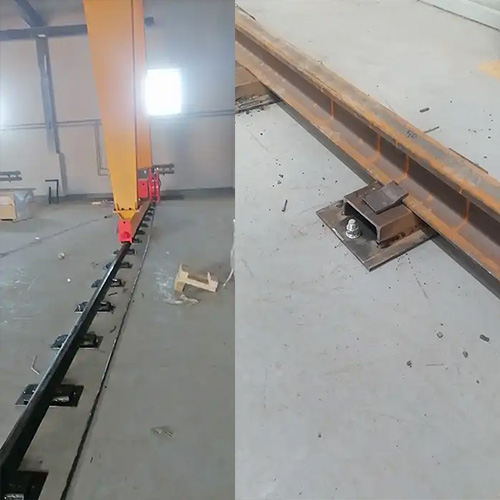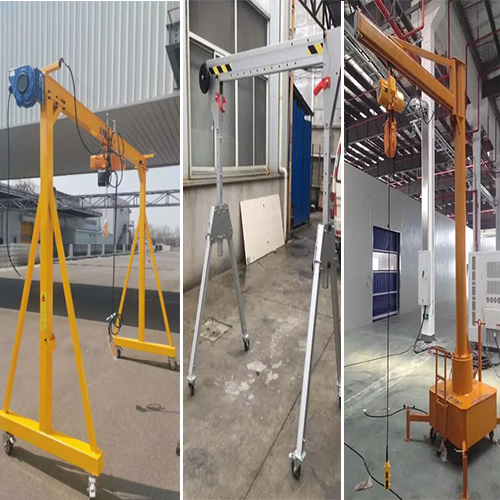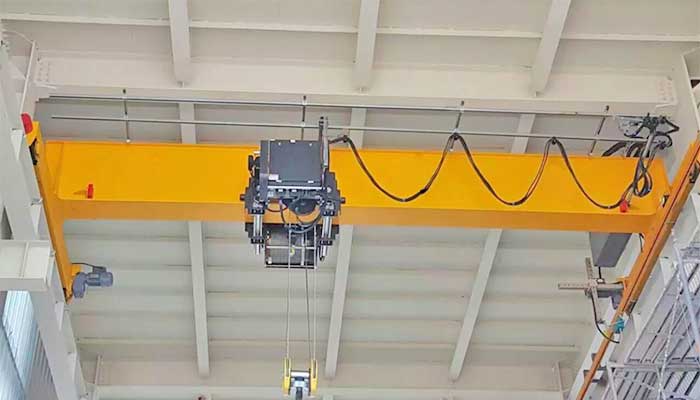
Remote Control Crane, Overhead Travelling Remote Crane
Radio remote control cranes increase safety, ergonomics,productivity & lower your overhead travelling crane downtime. Remote control cranes for sale.
Remote control crane, why to use remote crane for your application?
Traditional pendant control cranes are rapidly being replaced by wireless remote control cranes all over the place, and it is one of the best things that has happened to in the material handling field in a long time. Wireless control is the way of the future, despite the opinions that traditional controls provide them greater control over the overhead travelling cranes and are simpler to manage when it comes to safety and security of operations. Let's take a quick look at the idea and discover the advantages wireless radio controls provide for the field of crane operations.
Overhead cranes and its operations
Prior to the invention of radio controls, there were only two types of controls used to operate the crane: wired pendant controls and bridge mounted cabin operated controls. Both had their advantages and disadvantages, but wireless controls effectively addressed their disadvantages.
Cabin controls are quite efficient in their use, although they typically need more than one operator to function properly. One person in charge of the overhead crane requires assistance on the ground with rigging and situating the loads. The most of operations also call for the installation of a relay person, who will watch over the work and give verbal or visual instructions as needed.
The majority of these issues were resolved using the wired pendant and crane controls. On the working floor, the operator was physically close to the load. He was able to position the load himself because he had a direct line of sight, eliminating the need for the relay person. But it also brought with it a new disadvantage. It was necessary for the crane operator to follow the crane's path across the factory floor. This introduced a hazard risk because the risk of tripping and falling increased. Because of this, the crane had to operate more slowly and cautiously, slowing down the process and decreasing efficiency and safety.
Benefits of radio remote controls
If you look back over the last few years, you will notice that the number of radio remote control cranes is growing by the day. It is becoming more popular as an alternative to the corded pendant control cranes. When dealing with the material handling industry, radio remote controls are generally preferred.
Wireless radio control cranes, in general, increase productivity and safety while decreasing downtime. However, operators find them easier to use in the field than corded pendant assemblies. Radio remote controls are becoming more cost-effective as technology continues to advance.
Let us look at the advantages of radio remote control cranes.
Increased safety and ergonomics
Radio remote controls are commonly used in the material handling industry when operating hoists and control cranes. When using these, operators must be aware of the surroundings in which the operations take place. It would ensure that the overhead crane can safely lift a variety of loads and is clear of any impediments.
The radio remote control crane operation gives the operator control of the overhead travelling crane. Instead of being tethered to the crane by a hardwired pendant cord, they can control the system from any nearby location. It improves mobility during the procedure. Because of the increased mobility, the crane operator can position themselves in a variety of critical locations. It gives the operator the ability to:
- Find better vantage points. It ensures that the load part is clear of any impediments.
- While moving through the lift, be mindful of any potential trip hazards and pinch points.
- Checking the load from various angles to ensure that the rigging is done correctly. It can help prevent the occurrence of snags and load shifts.
- By using the radio remote control, the crane operator can protect themselves and the other workers nearby in the designated area.
- It also helps to protect the surrounding equipment and even the load itself from damage.
The ergonomics principle was taken into consideration when designing the radio transmitters for the radio remote controls. It simply enables the remote crane to provide accurate and continuous control , while also managing to lessen operator hand fatigue. Even if the overhead travelling crane is operated for hours, the new remote control crane design helps in maintaining a safe working environment throughout the work shift.
Various applications require crane operators to control multiple functions at the same time. Using the pendant control during operation can be tricky because the process is less operator-friendly. However, with a radio and a remote control, one can have greater ease of use. Even when using multiple controls, the crane operator can keep proper spacing and size to accommodate a gloved hand.
Increase in productivity
It is well known that radio remote control cranes can help in the operator's mobility. It is also known to increase the operator safety while decreasing cycle times. The operator is not tethered to the equipment with a pendant while using the remote control. As a result, the operators have complete freedom to move around the facility. It enables them to keep production running smoothly.
Tasks that involve using a variety of machines to complete the operation can be difficult. However, since the invention of radio remote controls, a single operator is now able to control numerous hoist and crane controls at once. This procedure does not require the use of any wired connections. All operations that require multiple operators and wired controls can be performed effectively and safely by a single operator.
Decreased downtime
Using a pendant crane during the material handling application is very common that almost every operator goes through. The crane pendant, however, frequently sustains damage during this process. As a result, downtimes are frequently extended. Production will be halted unless the equipment is repaired.
If the transmitter is prone to damage during radio remote controls, the square transmitter can quickly rectify the situation with minimal downtime. It is much easier to protect the transmitters from damage now that they can be easily stored in any secure location when not in use. However, in the case of the pendant, they are constantly exposed to the workplace environment, making them easily damaged.
Ideal for unique application
Radio remote control systems are ideal for a wide range of unique applications. When the installation of the operating system is time-consuming and labor-intensive, such as the pitch and catch system, festoon-less crane system, and multiple-unit control, the radio remote crane control works well.
No one else can operate the overhead crane until the operation is finished. If the radio remote control system is used, it creates a safe environment for the operation and the other workers. Furthermore, the equipment can be controlled without the use of wires. However, with the rising cost of conductors, the cost of radio controls may be on the lower side. Festooning is no longer required because the conductor bar, bridge panel, hoist panel, and girder can control both the crane and the receiver.
What do wireless controls bring in?
The introduction of wireless remote controls addressed both of the aforementioned disadvantages of traditional controls. First of all, the operator is positioned on the ground and is able to handle the rig and positioning tasks from that position alone, obviating the need for the additional spotter. It also provides the operator with improved visibility because he or she can position the controls in the best floor location available to monitor the crane's operation.
Control precision is also improved because wireless crane controls allow the operator to move in closer to the load when it is safely positioned. The operator also has the choice to move away from dangerous weights and manage the operations from a secure distance in such cases. In conclusion, wireless controls liberate the operator's position in relation to the load and eliminate the need for him to move with it. But the operator must stay outside in the designated fall zone. As a result, it improves workplace safety when it comes to crane operations.
How do wireless control cranes minimize the operator's risks?
There is always a risk that the materials will fall on the crane operator when working with heavier loads and cranes, unless the operator is safely positioned away from the heavy load itself. Other factors that increase the risk of operating a crane are as follows.
- Mechanical breakdown.
- The operator's incompetence.
- Slip and fall hazards
- Reduced line of sight between the operator and the load.
- The operator is located within the marked safety zone.
The wireless remote controls give operators positioning flexibility, and hence he is always outside the fall or danger zone. The line of sight and visibility is also enhanced due to this flexibility. Any impending danger or hazardous possibility is then noticed beforehand, and team members can alert the crew and prevent it from occurring.
How does it reduce human incompetence?
As was already discussed, manual errors caused by human error frequently result in dangerous situations. We greatly benefit from the wireless controllers in this situation. First and foremost, we need to confirm that the operators have received the necessary instruction and are licensed to operate the overhead hoisting equipment and its wireless controls. Making sure the operator has the necessary skills minimizes the possibility of producing an operational weakness.
The modern controls, which include wireless remote capabilities, include safety features that improve the operator's capability. This adds an extra layer of security, which helps in the prevention of operational flaws that could lead to fatal accidents. The following are the built-in features that improve operation controls.
- Easily accessible to stop switch.
- Key interlocks.
- Supervisory functions.
- Ergonomic design eliminates the possibility of random operational glitches.
- LED indicators, as well as enhanced feedback and haptic vibrations
In factories and warehouses, crane controlling has always been one of the most common and routine operations. The main goal of warehouse hoist and crane equipment has always been to improve convenience, use, and operational safety.Radio remote crane has greatly increased the efficiency and effectiveness of crane operators while also enhancing their safety standards.
Push Button Pendants Vs Radio Controls- A Comparative Study
With the help of the controls, an operator directs the crane's movement along with the hoist. There are three main types of movements:
- Crane motion - when you move the crane travelling horizontally .
- Hoist lifting motion- When you move the hook up and down.
- Hoist positioning - lateral or side to side movement signifies the hoist positioning.
Now we'll look at the differences between push button pendants and radio controls.
Definition
- Push Button Pendants: This is a handheld crane controller. It is electrically connected to the hoist. It hangs down so that the operator may use it accurately. The operator will also have the ability to walk alongside the load and crane while also holding the control pendant. The electric hoist can be placed laterally by the operator. Additionally, with the help of the pendant control, he or she has control over the lifting motion of the hook.
Radio controls: Radio remote controls are wireless remote transmitters. It includes several levers or buttons. Here, a radio receiver receives the radio signal that the radio transmitter has sent. Signals are converted into electrical energy by the device. After that, the relevant contact is activated, allowing the crane to move up and down.
Benefits of pendant controls
- Because of their incredible ergonomic design, pendant controls are preferred by many operators. The operators can therefore totally rely on them. Additionally, the ergonomic designs will guarantee that the operators won't experience problems.
- Today's pendant controls are more compact and lightweight, enabling operators to operate it with just one hand.
- As they have a festoon style, their greatest benefit is reliability. As a result, there won't be any interference concerns between the remote radio transmitter and the receiver.
- The insulated design will safeguard the operators against shocks. Additionally, it has strong impact resistance and can withstand moisture, corrosion, filth, dust, and grime.
- Being in the suspension form prevents the operators from dropping it.
Disadvantages of pendant controls
- The operator stays close to the load, which is a key drawback of pendant controls. As a result, the operator is constantly at risk of accidents.
- The operator is also exposed to hazardous substances and materials. For instance, certain hot metals can result in unintended accidents.
- Another big disadvantage that the operator will face is that he or she must move with the loads. Collision hazards are increased as a result. Specifically, you might trip and injure yourself.
Benefits of using radio controls
- Radio control cranes were not commonly used by operators in the past. It was pricey, and that was the main reason. However, as time went on, the technology improved. They are currently a reliable and solid alternative.
- They are being offered for a reasonable low price. It increases its appeal to customers. You can purchase a transmitter and receiver of good quality at a fair price.
- You'll have flexibility if you use a radio control. You are not required to constantly stand by the crane's side. Using radio controls, you may control your cranes from a distance.
- You will be shielded against a wide range of dangers, including radiation, vapor, smoke, dampness, and high voltage. The radio controls, on the other hand, are perfectly safe.
- It improves the operator's visibility. Additionally, you can run the operations without hiring a workforce. You can achieve your goals with with one operator. This will result in some financial savings.
- The operator can position the load more quickly by using remote control. He or she can assess the burden more accurately from the ground.
Disadvantages of radio control
- It is incompatible with cranes of the class A and B. The cranes' battery-powered control system is the reason. Therefore, using a radio control to operate it will quickly train the battery.
- You need to replace the batteries in your radio control pretty frequently once more. You must periodically check the batteries for it. It can give the operator headaches. It can negatively impact your output if you don't properly maintain it.
- Because it is a handheld device, it is more vulnerable to damage. It is made of plastic and rubber, which ensures its ability to withstand damage. It does, however, have a limitation. It will be harmed if you drop it repeatedly.
- The transmitter is not connected to the crane. As a result, it is possible that it will be misplaced. To avoid this, you must plan ahead of time for central storage.
So there we have it: the distinctions between radio controls and push-button pendants. Going over the points listed above will help you understand these types of controls. Knowing what to look for before purchasing a crane will help you make the best decision. You will be able to bring the best radio control on board, which will benefit your business.


